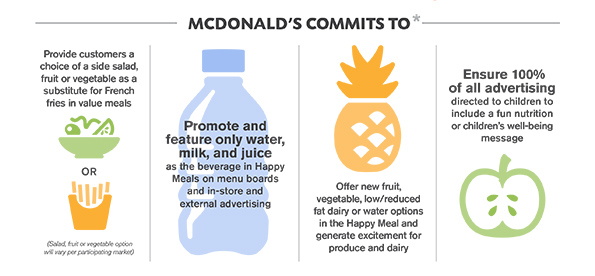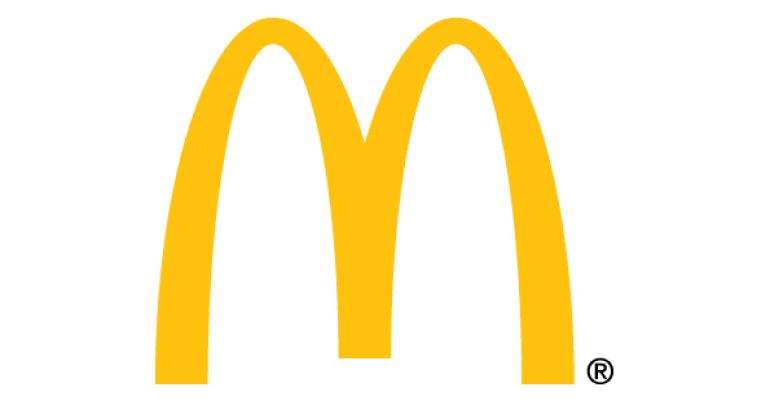McDonald’s removal of soda from the Happy Meal section of its menu boards has resulted in an increase in milk and juice sales, McDonald’s USA said Thursday.
The number of customers choosing milk or juice with Happy Meals has increased to 46 percent, compared with 37 percent before the menu board change, McDonald’s said.
Conversely, Happy Meal soda sales have declined. The percentage of customers choosing soda with Happy Meals has dropped to 48 percent, compared with 56 percent before the menu board change.
The numbers come from a report issued by the Oak Brook, Ill.-based operator outlining its progress on five nutrition goals to increase customer access to fruits and vegetables and help families make informed choices.

The goals were set in 2013, in partnership with the Alliance for a Healthier Generation, created by the Clinton Foundation and the American Heart Association, in part to address growing criticism from nutrition advocates that the quick-service chain was contributing to an epidemic of obesity among children in particular.
“We’re making progress in areas that matter most to our customers, business and society,” McDonald’s Corp. president and CEO Steve Easterbrook said in a statement. “Our actions demonstrate the influence of our scale and the impact of our partnerships. We’ll continue to work with the Alliance for a Healthier Generation to offer more choices to our customers around the world.”
McDonald’s pledged to make nutrition improvements in 20 major markets, including the U.S., with the goal of reaching all markets by 2020.
Keybridge, a public policy consulting firm based in Washington, D.C., looked at how the company was doing in reaching its goals, focusing specifically on the U.S. and Italy.
Here are the five goals and how McDonald’s has fared so far in the U.S.:
Goal 1: Feature only water, milk and juice as Happy Meal beverage options on menu boards and in-store and external ads directed at kids. Sodas are still available as an option, but are not listed on menu boards.
The menu board change rolled out in July 2014, and all of McDonald’s U.S. locations were in compliance by February 2015. Within 11 months after the menu board change in July 2014, McDonald’s had sold 21 million more low-fat and fat-free milk jugs and apple juice boxes than before the change.
Goal 2: Offer side salad, fruit or vegetables as a substitute for fries in value meals.
U.S. locations started offering alternatives to fries in January 2015, and 83 percent of units surveyed included side salads, vegetables or fruit by February 2015. Of those, 73 percent offered side salads only, 1 percent offered a vegetable option only and 9 percent offered multiple side options. Four percent, however, charged more for the substitution, the report found.
The report didn’t indicate how often consumers chose those alternatives.
McDonald’s said it sold 38 million Cuties clementines between November 2014 and March 2015, in Happy Meals or a la carte, and 380 million bags of apple slices in 2014.
Goal 3: Use Happy Meal and other packaging innovations to generate excitement for fruit, vegetable, low-fat and reduced-fat dairy, or water options for kids, and offer them in Happy Meals.
Among U.S. restaurants, all offered apple slices, 98 percent offered clementines and 97 percent offered low-fat Go-Gurt yogurt tubes. McDonald’s said it has sold 161 million Go-Gurt tubes between July 2014 and May 2015.
Goal 4: Dedicate one Happy Meal box or bag panel four times a year to communicate a fun nutrition or well-being message.
McDonald’s USA exceeded expectations in 2014. During the year, the chain introduced 11 Happy Meal boxes and three bags with nutrition or well-being messages.
Keybridge found that it could not directly verify that restaurants were using the qualifying Happy Meal boxes and bags, but it said most restaurants followed McDonald’s implementation schedule.
See more goals
Goal 5: Include fun nutrition or well-being messages in all advertising directed at kids.
This was a goal McDonald’s met early in the U.S., in part because in 2006 the chain was a founding member of the Children’s Food & Beverage Advertising Initiative, a self-regulating program of the Council of Better Business Bureaus designed to shift children’s food ads to encourage more healthful choices. Participants pledge to advertise only foods that meet certain nutrition criteria directly to kids on networks like Disney or Nickelodeon.
By January 2013, all of McDonald’s ads directed at kids, both on TV and digital media, featured a nutrition or well-being message, the Keybridge report found.
Margo Wootan, director of nutrition policy at the Center for Science in the Public Interest, said the decline in sodas in Happy Meals was a promising result, but more work could be done.
“After decades of marketing soda and fries to kids, that’s what everybody has gotten used to. So it will take time to get to the point where most families are choosing low-fat milk or water with Happy Meals,” Wootan said.
Wootan said McDonald’s could do more to come up with more interesting and appealing side dishes as an alternative to fries, for example.
“They need to help turn that around, to help change those attitudes and provide more appealing options,” she said. “They should be helping to make up for their decades of marketing fries” as the default side dish.
Efforts to improve nutrition have continued. Earlier this year, McDonald’s pledged to stop using chicken treated with human antibiotics in U.S. restaurants over the next two years. The chain will also move away from milk coming from cows treated with growth hormones.
McDonald’s operates or franchises about 34,000 restaurants around the world, including more than 14,000 units in the U.S.
Contact Lisa Jennings at [email protected].
Follow her on Twitter: @livetodineout

